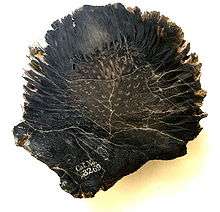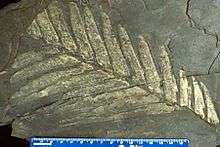Bennettitales
Bennettitales (also known as cycadeoids) is an extinct order of seed plants that first appeared in the Permian period[1] and became extinct in most areas toward the end of the Cretaceous (i.e. they existed from about 252 to 66 million years ago),[2] although some Bennettitales appear to have survived into Oligocene times in Tasmania and eastern Australia.[3] The taxon comprises two groups, the Cycadeoidaceae, represented by Cycadeoidea and Monanthesia, and the Williamsoniaceae including Williamsonia, Williamsoniella, Wielandella and Ischnophyton which had slender, branching trunks and either bisporangiate or monosporangiate strobili.[4]
| Bennettitales | |
|---|---|
 | |
| A Cycadeoid, showing an "inflorescence" in the top-right | |
| Scientific classification | |
| Kingdom: | |
| (unranked): | |
| Division: | Cycadeoidophyta |
| Order: | Bennettitales † |
| Families | |
Description
Originally, Bennettitales were thought to be cycads for their strap-like leaves, however their flower-like reproductive parts separate the two groups. The two families of Bennettitales (Cycadeoidaceae and Williamsoniaceae) each have their own unique traits. Cycadeoidaceae had stout trunks and bisporangiate strobili (cones) serving as their reproductive structures and Williamsoniaceae either had bisporangiate or monosporangiate cones, and distinctly slender and branching woody trunks.[4] These bisporangiate cones consist of layers of protective bracts, a curved microsporophyll, and an ovulate receptacle.[5] The bisporangiate cones remained closed at maturation, and most likely were obligate self-fertilizers.[6]
In general, Bennettitales had leaves attached adaxially (toward the stem) with a distinct midrib. Veins stem from the midrib at an approximately 90 degree angle.[7] They have tough cuticles as well, as they were able to withstand high sulfur dioxide levels in the Triassic/Jurassic period for considerable time.[8] Some were characterized by thick trunks and pinnately compound leaves that bore a superficial resemblance to those of cycads, differing primarily in stomatal arrangement.[9]
Taxonomy
Bennettitales were first identified by Engler in 1892 as separate from Cycadales, and were then further differentiated into the two groups Cycadeoidaceae and Williamsoniaceae by Caruthers. The Euanthial hypothesis erected by Arber and Parking in 1907[10] posited that angiosperms arose from Bennettitales, as evidenced by the wood-like structures and rudimentary flowers. This theory placed them among the anthophytes, leading it to be known more commonly as the Anthophyte hypothesis.[4] Based on morphological data, however, Bennettitales were classified as a monophyletic group when paired with Gnetales.[11] Genetic data showed that modern extant seed-plants form their own monophyletic group, excluding Bennettitales.[2] Modern theory suggests that Bennettitales, Angiosperms, and Gigantopteridales form a clade based on the presence of oleanane.[12] Recent evidence from examining phase-contrast X-ray images of gymnosperm seeds suggested that the Euanthial hypothesis is supported.[13] This is still a hotly debated topic. Mostly, it is understood that by morphological data, Euanthial hypothesis is supported but modern cladistic tests suggest otherwise.[14] Uncovering information about this extinct group is still far from finished, as new species are being discovered such as Nilssoniopteris binggouensis in 2014[15] and Anomozamites sanjiaocunensis in 2015.[16]
Bennettitales are also linked to the diversification of insects due to their flower-like reproductive parts. Specifically, the origin of insect mouth parts is connected to Bennettitales and Gnetales.[17]
Gallery
- A fossilised Bennettite, squashed by later compression.
- Side view. Note embedded "flowers".
- A flower-like structure.
 Fossil leaf of Zamites mariposana from the Jurassic.
Fossil leaf of Zamites mariposana from the Jurassic.
References
- Patrick Blomenkemper; Hans Kerp; Abdalla Abu Hamad; William A. DiMichele; Benjamin Bomfleur (2018). "A hidden cradle of plant evolution in Permian tropical lowlands". Science. 362 (6421): 1414–1416. doi:10.1126/science.aau4061. PMID 30573628.
- Foster, C. S. P. (2016). "The evolutionary history of flowering plants" (PDF). Journal and Proceedings of the Royal Society of New South Wales. 149: 65–82.
- McLoughlin, S., Carpenter, R.J. & Pott, C., 2011. Ptilophyllum muelleri (Ettingsh.) comb. nov. from the Oligocene of Australia: Last of the Bennettitales? International Journal of Plant Sciences 172, 574–585
- Speer, Brian R., 2000. Introduction to the Bennettitaleshttp://www.ucmp.berkeley.edu/seedplants/bennettitales.html
- Arens, Nan C.; Stromberg, C; Thompson, A. "Introduction to the Bennettitales". Retrieved April 16, 2018.
- Osborn, Jeffrey M.; Taylor, Mackenzie (2010). Pollen and coprolite structure in Cycadeoidea (Bennettitales): Implications for understanding pollination and mating systems in Mesozoic cycadeoids. Bloomington, IN: Indiana University Press. pp. 34–49.
- Ray, M. M.; Rothwell, G. W.; Stockey, R. A. (September 2014). "Anatomically Preserved Early Cretaceous Bennettitalean Leaves: Nilssoniopteris corrugata n. sp. from Vancouver Island, Canada". Journal of Paleontology. 88 (5): 1085–93. doi:10.1017/S002233600005767X – via ResearchGate.
- Steinthorsdottir, M.; Elliott-Kingston, C.; Bacon, K. L. (March 2018). "Cuticle surfaces of fossil plants as a potential proxy for volcanic SO2 emissions: observations from the Triassic–Jurassic transition of East Greenland". Paleobiodiversity and Paleoenvironments. 98: 49–69. doi:10.1007/s12549-017-0297-9.
- Pigg, Kathleen. 2005 The Cycads, Cycadeoids (Bennettitales) and Ginkgophyteshttp://lsweb.la.asu.edu/kpigg/CYCAD.html (accessed 21 Sept 2007).
- Arber, E. A. Newell; Parkin, John (July 1907). "On the Origin of Angiosperms". Botanical Journal of the Linnean Society. 38 (263): 29–80. doi:10.1111/j.1095-8339.1907.tb01074.x.
- Crane, Peter R. (September 1985). "Phylogenetic relationships in seed plants". Cladistics. 1 (4): 329–348. doi:10.1111/j.1096-0031.1985.tb00432.x.
- Taylor, D. W.; Hongqi Li; Dahl, Jeremy; Fago, F. J.; Zinneker, D. & Moldowan, J. M. (2006). "Biogeochemical evidence for the presence of the angiosperm molecular fossil oleanane in Paleozoic and Mesozoic non-angiospermous fossils". Paleobiology. 32(2): 179–90. doi:10.1666/0094-8373(2006)32[179:BEFTPO]2.0.CO;2.
- Friis, E. M.; Crane, P. R.; Pedersen, K. R.; Stampanoni, M. (December 2007). "Phase-Contrast X-Ray Microtomography Links Cretaceous Seeds with Gnetales and Bennettitales". Nature. 450 (7169): 549–52. doi:10.1038/nature06278. PMID 18033296 – via ResearchGate.
- Rothwell, G. W.; Crepet, W. L.; Stockey, R. A. (January 2009). "Is the anthophyte hypothesis alive and well? New evidence from the reproductive structures of Bennettitales". American Journal of Botany. 96 (1): 296–322. doi:10.3732/ajb.0800209. PMID 21628190.
- Na, Y.; Sun, C.; Dilcher, D. L.; Li, Y. (March 2014). "Nilssoniopteris binggouensis sp. nov. (Bennettitales) from the Lower Cretaceous of Northeast China". International Journal of Plant Sciences. 175 (3): 369–81. doi:10.1086/673539 – via ResearchGate.
- Miao, Z.; Sun, C.; Dilcher, D. L.; Na, Y. (January 2015). "Anomozamites t BennettitalesD from Middle Jurassic Haifanggou Formation western Liaoning China". Global Geology. 18: 75–87 – via ResearchGate.
- Nel, P.; Bertrand, S.; Nel, A. (February 2018). "Diversification of insects since the Devonian: a new approach based on morphological disparity of mouthparts". Scientific Reports. 8 (1): 3516. doi:10.1038/s41598-018-21938-1. PMC 5824790. PMID 29476087.